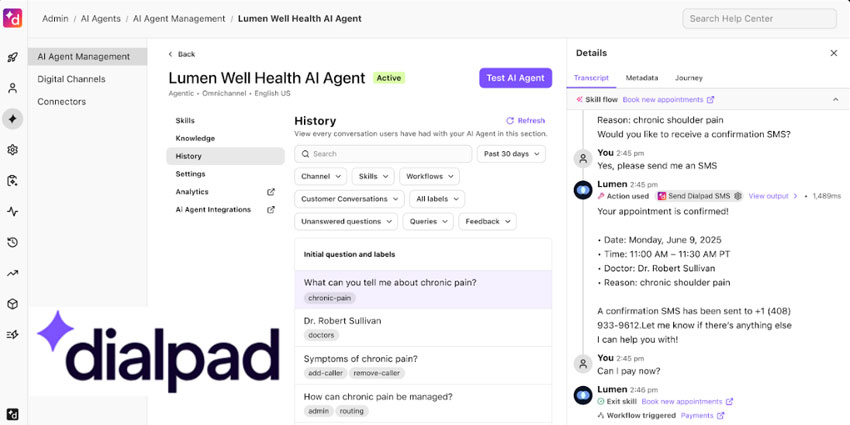In a world of digital transformation and accelerating customer expectations, every contact center is striving for the same thing: agility.
Business leaders can no longer afford to be tied down by static, legacy equipment, and complex hardware. As such, many contact center teams are moving to the cloud to embrace a future where employees can deliver excellent experiences from anywhere, on any platform, at any time.
CCaaS also allows contact centers to be as fluid and dynamic as their customers’ needs are, bolstering DevOps initiatives that pave the way for rapid updates, growth, and innovation.
Here’s how DevOps is transforming the contact center as we know it.
The Rising Demand for DevOps in the Contact Center
DevOps is an operational approach to innovation, ideation, and development, and is often the ideal option for today’s transformative contact centers.
After all, IT teams in the cloud can move on from the monotony of maintaining and priming servers and refocus their time on building, testing, optimizing, and embedding new contact center workflows.
That prospect is helping to push the value of the CCaaS space forward, with the market expected to be worth a whopping $54.6 billion by 2027.
Max Lipovetsky, Executive Vice President of Product at Cyara, doubles down on this point. He notes that “the desire for flexibility, agility, and innovation, in addition to cost-effective and higher availability operations,” is increasing overall CCaaS migrations.
Moreover, the DevOps approach helps break down the silos separating IT development and operations, streamlining collaboration between both departments. As a result, companies can often evolve, adapt, and grow faster.
Indeed, DevOps helps companies make the most out of the flexible CCaaS environment, giving businesses a foundation to build an agile growth strategy. This may lead to:
- Faster problem solving and solution delivery
- Greater resiliency
- Improved performance via automation
- Significantly reduced costs
- Improved customer satisfaction.
How to Bring DevOps into the Contact Center
For companies making the transition to CCaaS, embracing a DevOps mindset might seem relatively straightforward. After all, DevOps and the cloud work so well together.
However, embracing the power of DevOps in the contact center requires companies to invest in a concentrated effort to update their culture and processes.
Step 1: Update Company Culture
Most people refer to DevOps as a methodology or practice, but it’s more of a mindset. There are no specific tools or technologies included in a DevOps strategy. What really makes this concept work is the right company culture and attitude.
According to a report on the “State of DevOps” from 2021, the most common cultural hurdles that prevent DevOps from thriving in a business include “discouraging reach,” setting “unclear responsibilities”, and devising poor feedback loops.
Eliminating these problems in favor of a more streamlined, collaborative, and experimental company culture allows DevOps to thrive.
Lipovetsky adds that, in fact, company culture can be the roadblock to successfully adopting DevOps altogether. He states:
“The key element of culture that stops this is the attitude to risk. To be truly agile, you need to accept a certain level of risk, and be confident that rapid iteration is going to manage the downside of this approach.”
Step 2: Implement Agile Practices
Both creating a powerful CCaaS environment and thriving in the DevOps landscape require companies to embrace a more “agile” approach to business.
Implementing agile methodologies, like rapid development strategies, analytics, and continuous testing can help companies start discovering the true benefits of DevOps in the contact center.
Yet, such a process requires contact center DevOps to become a team sport. As Lipovetsky says:
“Effective agile practices require empowered cross-functional teams, with representation from the business, development, operations and quality assurance.
“Bringing everyone together and aligning them to outcomes and risk appetites enables faster innovation and better customer results.
“In turbulent times such as we are currently experiencing, this approach can make all the difference.”
Step 3: Take Advantage of Automated Testing Tools
CCaaS platforms increasingly offer the low-/no-code tools that allow developers to create new contact center experiences with drag-and-drop tools.
Now, with the rise of generative AI, some will soon likely offer natural language interfaces to streamline the process further.
Such an approach accelerates every part of the develop-test-optimize-embed process that DevOps initiatives often follow – except for the “test” section.
Unfortunately, that is when most of the DevOps workflow now gets stuck, as businesses follow manual testing procedures, experimenting to find any number of potential faults.
That is just the faults that they may expect to see in such a project, not those that they may not have come across before and only capture their attention once they deploy the new solution.
Thankfully, there are now automated testing tools that help businesses run tests more quickly and efficiently across every channel.
Such solutions track issues in both pre- and post-production, checking for problems like voice quality, data security, and more.
Step 4: Monitor Performance in Real-Time
After implementing a DevOps solution, new issues may emerge as new processes come into place, integrated technologies evolve, and other departments change their workflows.
Often, these create issues often take months to pinpoint – or often swim under the radar for years.
“This is where a continuous approach to testing can make all the difference,” says Lipovetsky.
“With continuous, agile testing, you can shorten the feedback cycle between the business, development, and QA teams, address uncovered defects at incremental levels before they compound in complexity, and exercise your systems to validate performance before errors creep into production and negatively impact CX.”
Step 5: Integrate New DevOps Solutions
As contact center companies make the transition into a new DevOps-focused culture, it’s worth thinking about how they can evolve and grow over time.
DevOps solutions which assist with things like planning and tracking, CI/CD orchestration and incident management can be extremely useful when preserving the momentum of the company’s transformation.
While not all of these solutions need to be integrated into the contact center straight away, it’s worth ensuring the connections can be made at some point in the future.
Planning ahead will ensure business leaders can avoid trying to stitch everything together with workaround solutions and code later.
Illuminating the Benefits of DevOps in the Contact Center
Ultimately, CCaaS environments make it easier for business leaders to deliver exceptional experiences to customers, which adhere to their ever-changing expectations.
The technology available ensures businesses have the opportunity to move and adapt quickly. However, to take full advantage of the many new possibilities DevOps brings, a mindset shift is necessary.
Embracing the benefits of DevOps ensures contact centers can unlock the agility needed to react to an ever-changing CX landscape at an accelerated speed.







